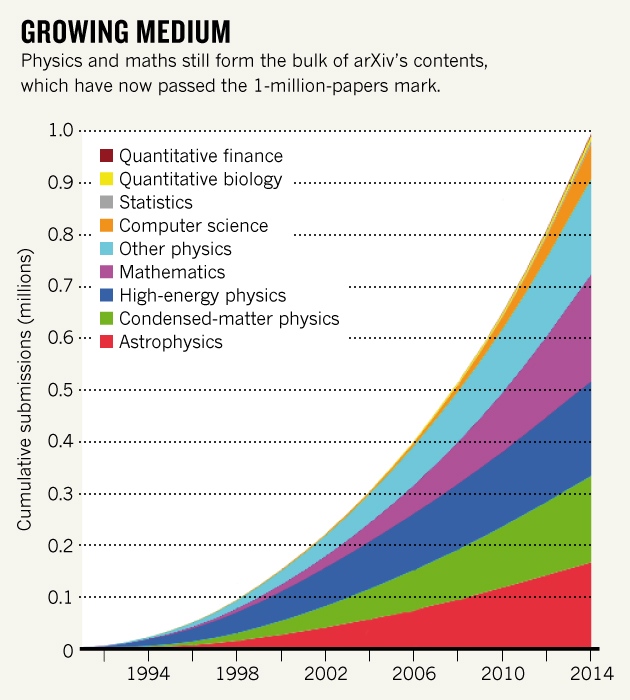
Richard Van Noorden, su Nature:
Ci sono voluti 17 anni per accumulare mezzo milione di manoscritti nell’archivio, varato come ‘electronic bulletin board’ nell’agosto 1991 un po’ prima dell’alba de World Wide Web, e appena sei anni per raddoppiare i suoi averi.
Era una una bacheca elettronica per un centinaio di fisici delle alte energie, per lo più colleghi californiani del fondatore Paul Ginsparg.
Ora i ricercatori sottopongono ad arXiv 8.000 articoli al mese, in media più di 250 al giorno. Gli amministratori li mettono a disposizione grezzi, senza peer-review, a pacchi, dopo un breve controllo di qualità, come una rapida occhiata all’appropriatezza da parte di uno dei 130 moderatori volontari e un filtro automatico per verificare la sovrapposizione del testo con quello di pubblicazioni già esistenti.
Il sito ha superato il milione di articoli il 29 dicembre, quando gli amministratori sono rientrati dalle vacanze e hanno aggiornato il server con manoscritti invitati dopo le ore lavorative, la vigilia di Natale (24 dicembre).
Media dei downloads 10 milioni al mese. Paul G. conta in un altro modo:
“The significance of 1,000,000 is just the base-10 accident that we happen to have 10 fingers, whereas some would argue that 220 = 1,048,576 is a more important number,” he says. “Also it’s the number of bytes in a megabyte.”
Paul G. e Daniel Citron, un suo studente a Cornell, hanno cercato sovrapposizioni di frasi lunghe sette parole in 757 mila testi depositati tra il 1991 e il 2012, per misurare
how chronic text reuse is distributed among authors in the dataset. We infer a baseline for accepted practice, perhaps surprisingly permissive compared with other societal contexts, and a clearly delineated set of aberrant authors. We find a negative correlation between the amount of reused text in an article and its influence, as measured by subsequent citations.
Il 6% degli autori, soprattutto non anglofoni, copiano brani senza attribuzione. L’analisi è uscita sui PNAS, e gratis su arXiv, of course. In fondo ai materiali supplementari, i due autori fanno ipotesi sulle cause del plagio. In parte sono culturali:
Many students from non-western cultures had never before heard the word plagiarism, and in some cultures it is considered disrespectful to rewrite another author’s words.
Più in generale:
it is entirely conceivable that the problem of excessive text reuse by some authors results as much from deficiencies in educational systems and
training as from willful fraudulence. One indication of this is the relative rarity of uncited reuse of text: that many researchers readily include blocks of text (though not within quotation marks) from cited sources suggests that they really do regard this as common practice, and have nothing to hide.
Similarly, they may believe that series of articles by the same authors are ordinarily produced from the same template, with large successive overlaps, as a standard practice. Producing a new idea is an act of magic, requiring substantial experience and training, and without correct mentoring it may be taken for granted that articles are instead produced by weaving together texts from existing sources.
Il taglia e cuci e premiato con incentivi legati alla quantità invece della qualità, il che potrebbe spiegare anche i 10 milioni di downloads…
While conceivably exacerbated by the ease of cutting and pasting text in electronic format, the problem does predate both the new technology and the use of preprints. Ironically the combination of those make make that reuse that much easier to detect.
Rif. anche il commento di John Bohannon su Science, con la “geografia” del plagio.
***
Su Climalteranti, il glaciologo Paolo Gabrielli recensisce La sesta estinzione di Elizabeth Kolbert. Sotto un post precedente, un signor Cerulli forniva un bell’esempio di globalcoolismo. Purtroppo le regole del sito non prevedono più di cinque commenti, il crescendo comico finale è stato cancellato prima che potessi ricopiarlo qui, sigh…
*
Articolo sui birrai americani (le birre artigianali hanno un grande successo anche in USA) dell’associazione Brewers for Clean Water che si mobilitano contro un gasdotto. Titoletto irresistibile “Man the beericades!”
*
Mal comune mezzo gaudio del giorno
In Italia un ministero e la presidenza del consiglio hanno concesso il patrocinio all’ICCFuF di Padova. In India, il governo ha varato una campagna di finanziamenti e propaganda della scienza induista, dalla medicina ayurvedica all’astronautica vedica. Risultato, il Mumbai Mirror annuncia il programma di una conf. scientifica assai più prestigiosa, con tanto di premi Nobel e medaglia Fields:
the five-day Indian Science Congress, scheduled to begin at Mumbai University’s Kalina Campus on January 3. (…)
In una sessione insolita
The first of the two speakers, Captain Anand J Bodas, told Mumbai Mirror that he believes “modern science is unscientific” in that it claims things it cannot understand do not exist. “The Vedic or rather ancient Indian definition of an aeroplane was a vehicle which travels through the air from one country to another country, from one continent to another continent, from one planet to another planet,” he said. “In those days aeroplanes were huge in size, and could move left, right, as well as backwards, unlike modern planes which only fly forward.”
(h/t Retraction Watch)
Questa collezione di cavolate farà parte della scienza induista?